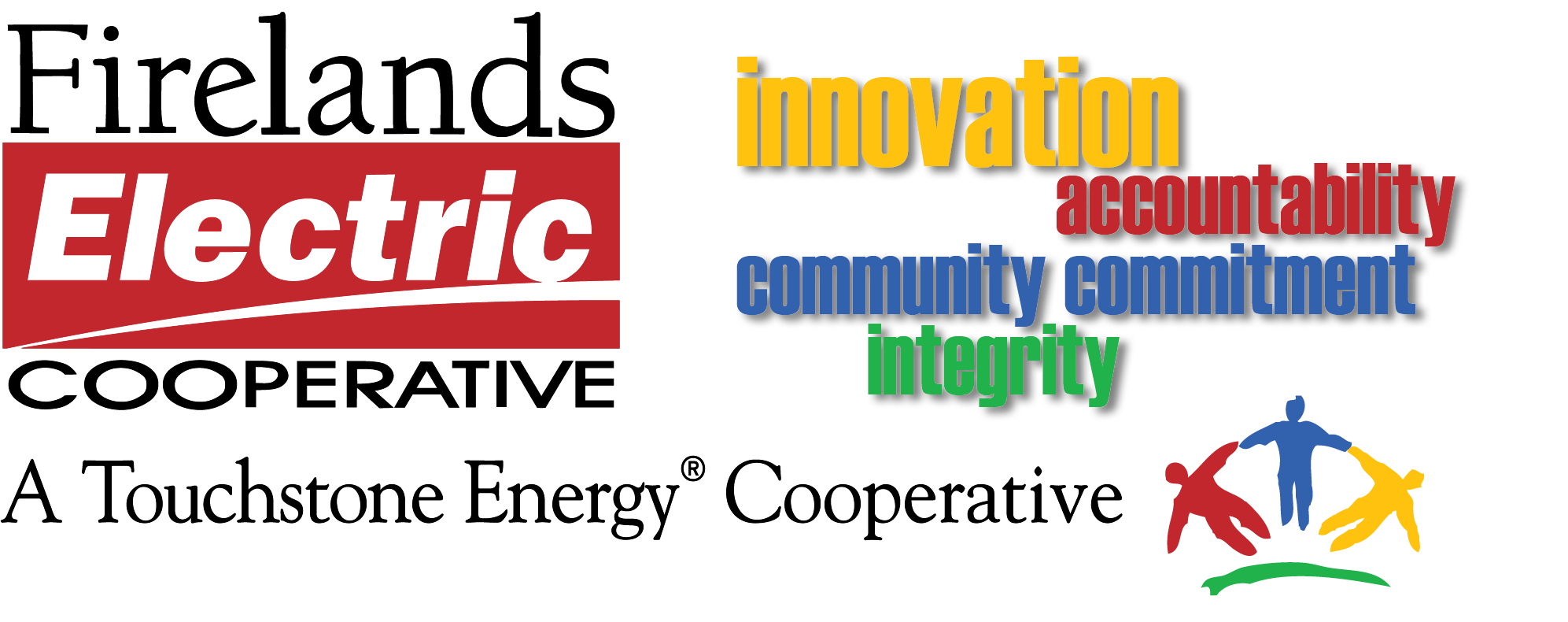WHAT'S IN A NAME?
The name Firelands is not unique to our cooperative. In May 2022, Firelands Electric Cooperative celebrates its 86th anniversary, and to mark this milestone, we take a closer look at the history of our namesake and our co-op in Ohio Cooperative Living magazine.
Click the links below to read this article, as well as a brief handwritten history by former Director of Finance and Accounting Harold Kirkpatrick.
What's in a name? - The history behind the name "The Fire Lands" and how the cooperative came to use this same name.
FEC history notes - A short history of Firelands Electric Cooperative, handwritten by Harold Kirkpatrick in 2002.
HISTORY OF FIRELANDS ELECTRIC COOPERATIVE
On May 11, 1935, President Franklin Delano Roosevelt issued Executive Order 7037, creating the Rural Electrification Administration (REA).One year later, Congress passed the Rural Electrification Act of 1936, which provided federal loans for the installation of electrical distribution systems to serve rural areas of the United States. The Rural Electrification Act dramatically improved life in rural Ohio. Before the Act’s implementation, only 10 percent of the people living in rural areas of the state had electricity in their homes and businesses.
By 1939, approximately 50 percent of Ohio’s farmers lived in homes with electricity. Ohio farm cooperative members were eager to have electricity on their farms and they were among the first in the nation to apply for federal funding when it became available.
Firelands Electric Cooperative, Inc. (FEC) was incorporated on May of 1936 as North Eastern Farm Bureau Electric Cooperative, Inc., located at 38 Wooster Street in Norwalk, Ohio. In January of 1938, and it was the 83rd electric cooperative formed in the country. Today there are more than 860 electric cooperatives nationwide, serving 42 million people in 47 states..
And then there was light
For rural Ohioans, it was an exciting day when the electricity was turned on for the first time. There were lights, and radios, and refrigerators — things we take for granted today. Rural electrification changed life on Ohio farms forever. REA crews travelled through the American countryside, bringing teams of electricians along with them. The electricians added wiring to houses and barns to utilize the newly available power provided by the line crews. A standard REA installation in a house consisted of a 60 amp, 230 volt fuse panel, with: 1 — 60 amp range circuit,1 — 20 amp kitchen circuit, 2 or 3 — 15 amp lighting circuits.
Northeastern Farm Bureau Electric Cooperative employees are pictured in the North Fairfield office (L-R): Agnes Eckstein, Leon Signs, Marcellus Geiger, and Ann Rotruck.
In August of 1938, Firelands’ first lines of Project “A” were energized, providing electricity to 90 new co-op members; Bronson Township School, Congers Grove, Norwich Township House, and the first group of co-op members: C.A. Bauer, L.J. Baumeier, Earl M. Beebe, Raphael Boose, H.A. Bordner, A. Bradford, Karl W. Brooks, E.V. Brooks, V.L. Brouhard, Orlo W. Brown, Logan Capelle, R.J. Carper, A.B. Carnahan, R.J. Carnahan, R.M. Cherry, Clarence Clause, Carl Daniel, William Daniels, E. Dannemiller, G.R. Dewitt, Lester Dewitt, L.J. Diehm, Lizzie Diehm, Chester Dooley, H. Dubois, W.E. Duffy, J.E. Earl, A.K. Eastman, D.F. Feathergill, Carl Feisler, Albert Foster, Vernon Fries, Omar Gharst, Rolla Gillner, Thomas Goatman, Joseph Hahler, N.S. Hakes, Dwight Hardy, Don Heisler, Russell Heisler, Frank Hettle, W.R. Hoyles, Dan Keiser, Charles Kirkwood, Jessie Kirkwood, A.G. Knoll, Arnold C. Knoll, G.E. Leak, T.F. Long, Charles Ludban, A.J. Manlett, Nellie O’ Mara, H.B. Miller, J.H. Mirtes, Mary Moffit, Albert Moll, D.D. Niver, N.B. Niver, Charles Noble, Ray Palm, A.A. Phillips, Frank Polacheck,, B.B. Robinson, J.D. Robinson, H.E. Ruggles, George Ryerson, Frank G. Schaffer, Charles Smith, H.V. Smith, Judson Sparks, U.B. Squire, W.B. Squires, Aaron Stoll, Carl Stuban, W.H. Sutherland, L.F. Thomas, J.W. Tidswell, V. Tidswell, Leon S. Trimmer, W.E. Trimmer, W.E. Whitright, H. Wiles, Frank Wise, S.F. Woodruff, Roy Wurtz, and William Young.
Several decendants of the original members are living in homes that were first served with electricity in August 1938.
The first office of the Northeastern Farm Bureau Electric Cooperative was in North Fairfield. As of December of 1938, 281 members were being served by 117 miles of line. By the end of January 1939, the members served had grown to 358 with 142 miles of line. Today, 9,037 Firelands members are served by 987 miles of line.
The first Annual Meeting of Members of Firelands Electric Cooperative, Inc. was held on Saturday, June 17, 1939 at the Huron County Fairgrounds, Norwalk, Ohio.
In December 1942, the New London Power and Light Company was purchased by Firelands, and the co-op headquarters were moved to New London in 1943. A lot has changed here at Firelands in the 75 years since the electric cooperative was incorporated. The average member used about 40 kilowatt hours (kWh) per month in 1939. Today, the average residential member uses 1,250 kWh per month. The average cost per kWh in the 1930s was about 9 cents and today it is 11 cents.
Some things have not changed however: Firelands Electric is still owned and controlled by its members, and still operates on a not-for-profit basis. Those hallmarks of a cooperative business haven’t changed, and aren’t going to change! Safety concerns were minimal in the early years, with linemen climbing poles (there were no bucket trucks) and working bare-handed, using uninsulated tools and equipment. Today, safety is our number one priority!
In 1942 the New London Power Company was purchased and the main office was relocated to 3 East Main Street, New London. That building is now part of the Pizza Explosion restaurant. In 1943, a warehouse was purchased and renovated for office and warehouse space which was used until 1976 — when the present office was built and put into service. Firelands Electric Cooperative office headquarters (1976-present), continues to expand and grow.
No matter what the future brings, one thing is certain, we’re 'Looking Out for You!'
